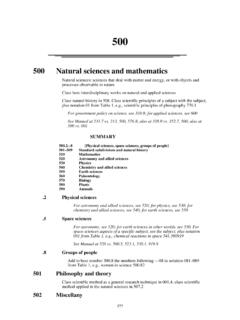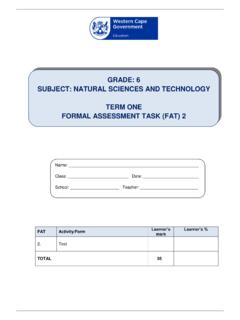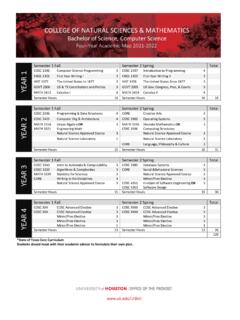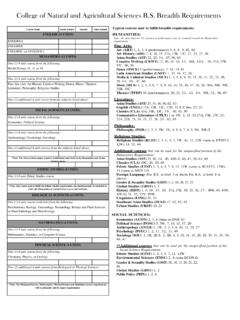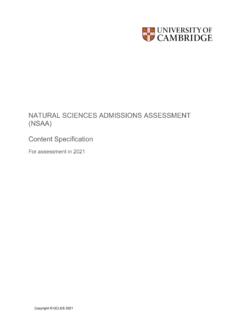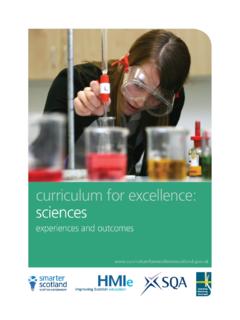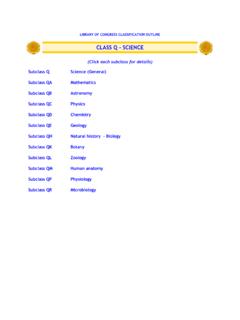Transcription of Natural Sciences and Technology - Grade 4 - Term 2
1 Natural Sciences and Technology - Grade 4 - Term 2 Topic 6 Materials around us Unit 1 Solids, liquids and gases 14 April 15 April 2020 Matter makes up all the materials and substances that exist on Earth. Everything around us is matter (Everything around us is either a solid, a liquid or a gas) Matter/ materials can exist in three different forms solids, liquids and gases We call these three forms the states of matter Properties of the three states of matter: o Solids Has a fixed shape You cannot change the shape easily, you will need some force to change the shape If you hit a brick with a hammer, its shape will change o Liquids Does not have a fixed shape A liquid will take the shape of the container you pour it in, it flows If you pour milk into a glass, it takes the shape of the glass.
2 When you pour it into a bowl, it will take the shape of the bowl o Gases Has no shape but it takes up space A gas moves around freely and spreads out into open spaces. You cannot keep it in an open container, the container must be closed You cannot see, feel or smell some gases Air is made up of different gases. If you blow up a balloon and tie it off, the gas (air) is trapped inside. But when you untie the balloon, the gas escapes and the balloon shrinks again. Unit 2 Change of State 16 April 17 April 2020 A substance changes from one state of matter to another when it gains or loses heat A thermometer is used to measure temperature (how hot or cold something is) o Temperature is measured in degrees Celsius ( C) o Water freezes at 0 C o Water boils at 100 C Melting o Changing from a solid to a liquid by adding heat o If ice cream gets warm and melts Evaporating o Changing from a liquid to gas by adding heat o When you boil water in a kettle steam (gas/water vapour) is released Condensing o Changing from gas to liquid by cooling it down o Gases condense when they lose heat o When you boil water in a kettle, hold a plate above it.
3 The steam will collect on the cold plate and change back into water Solidifying o Changing from liquid to solid by cooling it down o If you put water in the freezer it will change into ice Unit 3 The water cycle 20 April 22 April 2020 The Earth has a limited amount of water The movement of water from the land and sea, to the air and back again Water will change its state through evaporation, condensation, melting and freezing o Water on the Earth s surface evaporates and moves up into the air as water vapour Water from the sea, rivers, dams is heated by the sun, and changes into gas o The water vapour cools and condenses as it rises into the air The gas collects in the sky because it cools down o Drops of water high in the air form clouds The more water that collects, the darker the clouds become o Drops of water will fall to the Earth as rain Water in the clouds can freeze and will fall to the Earth as snow or hail.
4 It will melt when it touches the warm surface of the Earth o Rain, snow and hail bring water back to the Earth s surface Topic 6 Activity 23 April 27 April 2020 1. Use the words to complete the sentences. states solids cool solidify shape space melt condense evaporate a. The _____ of substances are solid, liquid and gas. b. _____ keep their shape. c. Liquids take the _____ of the container they are in. d. Gases have no _____, but they take up _____. e. When we heat solids, they _____ and become liquid. f. When liquids are heated they _____ to form gases. g. When gases _____ they _____ to form liquids. h. When liquids cool, they _____ and become solid. 2. Identify the states of matter (materials) in each of the pictures.
5 _____ _____ _____ _____ _____ 3. Which changes listed below are examples of melting and which are examples of solidifying? Give a reason for each answer. a. You have a piece of chocolate in your pocket on a hot day. b. You put jelly in the fridge to set. c. You put butter in a pan so that you can fry an egg. 4. Identify the change of state in the following parts of the water cycle: a. Clouds form _____ b. Snow forms _____ c. Water vapour forms _____ d. Snow becomes liquid water _____ Topic 7 Solid Materials Unit 1 Raw and Manufactured Materials 28 April 30 April 2020 Raw materials are Natural material such as wood, sand and clay that can be used to make things Natural materials come from nature Sometimes we can use raw materials as they are When people change raw materials to make something else, we call it manufactured materials Raw materials that are used to make other materials.
6 O Sand is used to make glass Rocks are broken down by the wind and water to become sand Sand is heated and melted into liquid The liquid can be shaped into different objects When it cools down, it solidifies to become glass objects o Clay is used to make ceramics Clay is made from very fine wet sand It can be shaped into different objects The objects are heated in ovens to become hard These ceramic objects are hard but brittle (it can break easily) o Coal and oil are used to make plastics, paints and fabrics Coal is a hard black substance that comes from deep underground Oil is a dark liquid that is found deep underground Through different processes coal and oil is used to make plastic objects, fibres such as yarn or fabric or paint.
7 O Animal wool and hides are used to make fabrics and leather Sheep s wool is spun into yarn. The yarn is woven or knit into fabrics Animal hides are changed into flexible soft leather to make shoes, handbags, etc. o Wood and fibre from plants are used to make paper Wood chips are cooked to a pulp. It goes through rollers that remove the water and dries the pulp out. Then the paper is cut into different sizes Unit 2 Properties of materials 4 May 5 May 2020 We make things out of different materials, that is why we need to know what the properties of the materials are what each materials looks like and how it behaves if you need a container to store water, the material that the container is made from must be.
8 O waterproof so that it doesn t leak o strong enough to hold the water o light enough to carry around Properties of materials o Hard or soft If you cannot scratch or dent a material, it is hard you can scratch a candle with your fingernail, so it is soft you cannot make a dent in a piece of wood, so it is hard o Stiff or flexible Flexible materials bend easily without breaking, a hosepipe Stiff material doesn t bend easily, a plastic ruler o Strong or weak Helps us to see if it is the right material to use a stone is very strong, but it is very heavy to build o Light or heavy Helps us to see if it is the right material to use Plastic is light but can also be very strong o Waterproof or absorbent Many fabrics are absorbent and can take in liquids, a washcloth Other materials don t allow liquids to pass through, a raincoat Topic 7 Activity 6 May 8 May 2020 1.
9 Match each word in column A with the correct description in column B. A B 1. Plastics a. Threads in plant and animal materials 2. Absorbent b. Made of clay and sand 3. Brittle c. Made from oil and coal 4. Fibres d. Breaks easily 5. Ceramics e. Soak up a liquid easily 2. Describe the raw material of each of the following: a. Ceramics b. Leather 3. Write a sentence to describe what glass is. 4. Tick the properties of glass, clay and plastic. Properties Glass Clay Plastic Flexible Brittle Becomes hard when baked Waterproof Soft 5. Use the words in the word box to answer the questions below. Wool slippers Wooden walking stick Polyester pillow Glass jug Floor tile Knitting wool Plastic shopping bag Plastic knitting needles a.
10 Name one object that is made of a hard material. b. Give two examples of objects that are made of soft materials c. List two objects that are made of stiff materials d. List two objects that are made of flexible materials. Topic 8 Strengthening Materials Unit 1 Ways to Strengthen Materials 12 May 15 May 2020 Structures like buildings must be strong enough to stand firm against powerful winds, hail and rainstorms The materials used must also be strong There are different methods/ ways to make materials stronger to build structures. Methods to strengthen materials: o Strengthen by folding Bending a material over on itself can make it stronger cardboard boxes have a folded layer in the middle that makes it stiff, harder and stronger to carry heavier things in.
